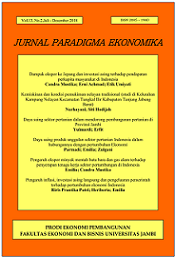Daya saing produk unggulan sektor pertanian Indonesia dalam hubungannya dengan pertumbuhan Ekonomi
DOI:
https://doi.org/10.22437/paradigma.v13i2.6677Abstract
This study aims to identify and analyze the competitiveness of Indonesian products in the agricultural sector, especially rice, oil palm, vegetables, fruits and livestock products, also the relation between economic growth and some commonly used competitiveness indicators. The approach used is RCA (Revealed Comparative Advantage), RSCA (Revealed Symetrics Comparative Advantage), Self Sufficiency Ratio (SSR), Import Dependency Ratio (IDR). The results of the study are as follows: The export performance of Indonesian agricultural products in general relatively weak. Almost all agricultural commodities have low competitiveness, except for plantation sub-sector products, especially rubber and palm oil which have high competitiveness, the remaining products such as horticulture, food crops, livestock products, and competitiveness of horticulture relatively low in the international commodity market. In this study, also found in general, the relation between the rate of economic growth and some magnitudes of international trade performance does not show a significant relationship for food crops, horticulture, plantations, and livestock products. Indonesia is approaching the stage of self-sufficiency, especially for food crops, but for other agricultural sector commodities, it is still very dependent on imports to meet domestic consumption needs.
Downloads
Downloads
Published
Versions
- 2018-12-29 (1)
- 2018-12-29 (1)









